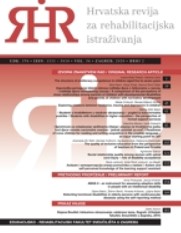SOCIAL RELATIONSHIP QUALITY AMONG WOMEN WITH SPINAL CORD INJURY – THE ROLE OF DISABILITY ACCEPTANCE
SOCIAL RELATIONSHIP QUALITY AMONG WOMEN WITH SPINAL CORD INJURY – THE ROLE OF DISABILITY ACCEPTANCE
Author(s): Agnieszka GabryśSubject(s): Social psychology and group interaction, Psychology of Self, Health and medicine and law
Published by: Sveučilište u Zagrebu, Edukacijsko-rehabilitacijski fakultet
Keywords: disability acceptance; social relationship quality; women with spinal cord injury;
Summary/Abstract: Interpersonal relationships among women with spinal cord injury are limited due to numerous barriers. The aim of this study was to investigate the role of disability acceptance in terms of the quality of social relationships among women with spinal cord injury. Social relationship quality was conceptualized as a construct that included two indicators, namely strength of relationship and social support. Ninety (N=90) women with spinal cord injury completed the Strength of Interpersonal Relationships Questionnaire (Zbieg and Słowińska, 2015), Social Support Scale (Kmiecik-Baran, 1995), and Multidimensional Acceptance of Loss Scale (Byra, 2017). Such methodological tools as descriptive statistics, correlation analysis (Pearson’s correlation coefficients) and progressive stepwise regression analysis were used. The study showed that the most important value for the surveyed women was the time devoted to relationships. The most frequent kinds of received support were informational and emotional. In addition, the most common change in the perception of disability acceptance was the containment of its effects and a transformation from comparative value to asset value. A significant correlation between the included variables was observed. It is also well worth mentioning that the two subscales of disability acceptance entailed a predictive function in explaining social relationship quality; however, the two subscales explained a surprisingly low percentage of observed variance. It is reasonable to suggest other ways of explaining this phenomenon.
Journal: Hrvatska revija za rehabilitacijska istraživanja
- Issue Year: 56/2020
- Issue No: 2
- Page Range: 121-131
- Page Count: 11
- Language: English

